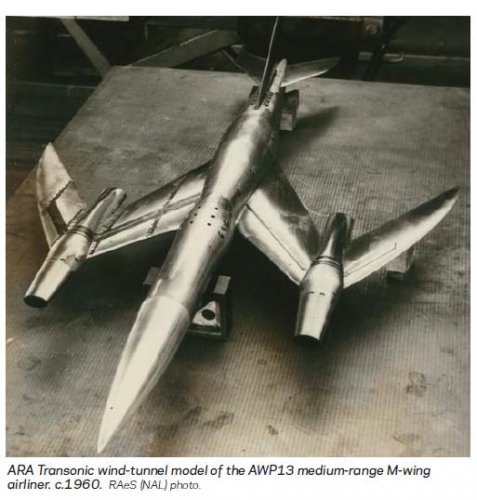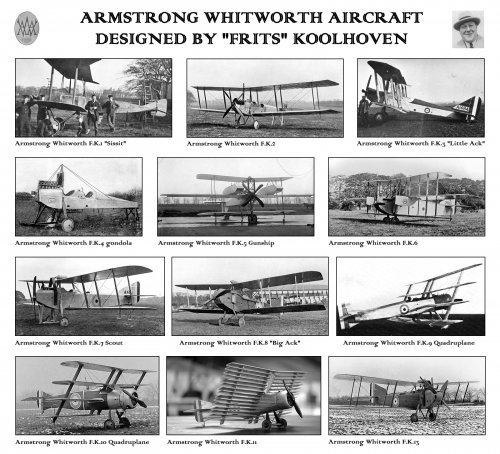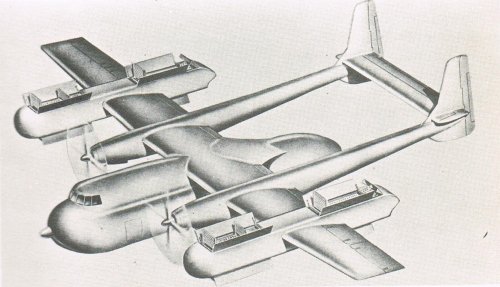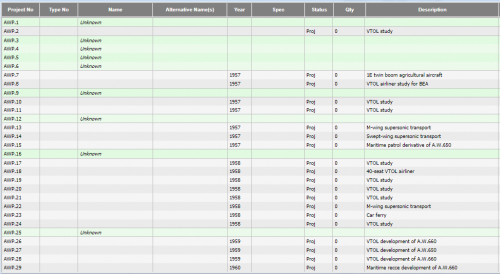- Joined
- 25 June 2009
- Messages
- 14,137
- Reaction score
- 4,320
Apparently no-one has yet tackled the subject on this forum, so here is my contribution. After days of research, it seems that there is no chance of ever filling the gaps in this list as even the sources of the time and the resources available do not give the type numbers for many A.W.A. aircraft.
NOTE: All dates are approximate and usually refer to the initial contract or inception of project.
The first period consists of Frederik Koolhoven's designs, which can be recognized by the letters F.K. (he then continued the series when working for B.A.T., starting with the Models F.K.22 and F.K.23).
All of the above were built except for the F.K.11. Then come a series of Koolhoven designs that were never built and pre-date his period at B.A.T., although there is no indication that they were actually done as part of what became Armstrong Whitworth. There is no indication of further numbers in the inhouse A.W. system. However, Koolhoven's retroative 1926 system contains designations of projects done under A.W. which conveniently carry on from there...
Between 1915 and 1919, Armstrong Whitworth also build airships:
After Fred Koolhoven's departure, Fred Murphy takes over and his designs carry his own initials as well. However, only one such designation has survived:
The Siddeley Deasy company is not yet a part of Armstrong Whitworth when it develops its first three aircraft types:
When Siddeley-Deasy becomes part of the Armstrong Siddeley group, the S.R.2 Siskin aircraft becomes the first major product of the new Armstrong Whitworth company. A new system of designations starts with the initials A.W. Unfortunately, the exact allocation of the first thirteen such designations is not known. Here is a list of the aircraft produced in that period:
Then comes the alphanumerical series as we know it, with A.W. followed by a sequential number, more or less in chronological order of design:
A few unbuilt projects didn't get an A.W. designation for unknown reasons:
Armstrong Whitworth becomes part of the Hawker Siddeley group. For some reason, projects from that point onwards take on an extra figure and become three-digit:
Finally comes the last episode in Armstrong Whitworth's history, the 600-series, consisting mostly of the Argosy transport (initially to be called "Freightliner"). Each new type gets a block of 10 numbers:
Other aircraft are associated with Armstrong Whitworth are the ones the company sub-contracted for Gloster and Hawker.
AVRO X
---------
Contracted construction of Avro Type 618 to Spec. 2/32 (needs to be confiirmed).
HART
------
Seven successive production orders starting in 1932 for the Hawker Hart in day bomber, communications and trainer variants for a total of 456 aircraft.
LANCASTER
-------------
contracted production of the Lancaster B.I, B.1B(FE), B.II and B.III variants for a total of 1238 aircraft.
LINCOLN
----------
contracted production amounting to 281 aircraft.
METEOR
-----------
sub-contracted production from Gloster of the Meteor F.4 and contracted production of the Meteor F.8.
Armstrong Whitworth was later contracted to develop a special test version, and then to develop/produce all night fighter variants of the Meteor; much later they also modified remaining NF.11 airframes to TT.20 (target towing version) standard. The designations A.W.60 to A.W.64 applied to the A.W. Meteors, but in some unknown order:
---------------
Although a Hawker design, Armstrong Whitworth becomes the sole developer/producer of most of the aircraft:
-----------
For this Hawker design, Armstrong Whitworth does only contracted production and no specific developments:
----------
For this Gloster design, Armstrong Whitworth does only contracted production and no specific developments:
NOTE: All dates are approximate and usually refer to the initial contract or inception of project.
The first period consists of Frederik Koolhoven's designs, which can be recognized by the letters F.K. (he then continued the series when working for B.A.T., starting with the Models F.K.22 and F.K.23).
- F.K.1 Sissit (1914) - small biplane scout and fighter prototype with 50 hp Gnôme engine (1 built)
- F.K.2 (1915) - tandem-seat biplane fighter with 70 hp Renault engine (2 built)
- F.K.3 "Little Ack" (1915) - tandem-seat biplane fighter developed from F.K.2 with 90 hp RAF 1a (343 built)
- F.K.4 (1915) - gondolas for SS.40-49 airships developed from F.K.3 fuselage, with 100 hp Green (probably 20 built as spares required)
NOTE: these were preceded by a gondola for SS.27 (also from an F.K.3 fuselage) but with a Renault engine (was it also F.K.4?)
and even before that a 1914 gondola for non-rigid naval airship HMA No.2 "Willows IV" (although Koolhoven involvement here is unsure) - F.K.5 Gunship (1915) - three seat, single-engined escort fighter triplane gunship prototype with 250 hp R-R (Eagle) (1 built)
- F.K.6 (1916) - multi-seat escort fighter triplane and Zeppelin destroyer prototype with 250 hp R-R (Eagle) (1 built)
- F.K.7 (1916) - developmental scout airplane with 160 hp Beardmore engine (production transferred to F.K.8) (1 built)
- F.K.8 "Big Ack" (1917) - scout and bomber biplane to replace the B.E.2c, 160 hp Beardmore engine (1700 built)
- F.K.9 (1916) - quadruplane fighter prototypes with 110 hp Clerget engine (2 built)
- F.K.10 (1916) - improved version of F.K.9 with 130 hp Clerget engine (8 built)
- F.K.11 (1916) - fifteen-wing design, planned engine unknown (not built)
- F.K.12 (1917) - wrongly allocated to the F.K.6 (because of the 1926 list), this remains a mystery, but given the chronology it could have been allocated to an improved FK.8 with modified cooling system, undercarriage and exhaust manifolds with 160 hp Beardmore engine (1 built)
- F.K.13 (1917) - known as the Fleet Fighter Reconnaissance Biplane, a version of F.K.8 completed March 1917 but not accepted, with a 200 hp Sunbeam engine (designation confusing because of the mix-up between the two systems — adding to the confusion was the reuse of the N513 serial number from an F.K.10 that was cancelled!)
All of the above were built except for the F.K.11. Then come a series of Koolhoven designs that were never built and pre-date his period at B.A.T., although there is no indication that they were actually done as part of what became Armstrong Whitworth. There is no indication of further numbers in the inhouse A.W. system. However, Koolhoven's retroative 1926 system contains designations of projects done under A.W. which conveniently carry on from there...
- F.K.14 (nd) - described by Koolhoven as an A.W. fighter design (not built)
- F.K.15 (nd) - described by Koolhoven as an airship gondola design for the Beta II (strange as this airship was built in 1912)
- F.K.16 (nd) - described by Koolhoven as an airship gondola design for North Sea airships based on the F.K.3 fuselage
- F.K.17 (nd) - described by Koolhoven as an airship gondola design for North Sea airships based on the F.K.3 fuselage
- F.K.18 (nd) - described by Koolhoven as a twin-engined flying boat project and precursor of the F.K.22; described elsewhere as a fighter project
- F.K.19 (nd) - described as an unbuilt aircraft; also found as a light air-cooled engine (unlikely if designed by Koolhoven)
Between 1915 and 1919, Armstrong Whitworth also build airships:
- SS.27 submarine scout airship
- SS.40 to SS.49 submarine scout airships
- HMA No.25 (later R 25) "23-Class" rigid airship
- R 29 "23X-Class" rigid airship
- R 33 and R 34 airships resembling the Zeppelin L33
After Fred Koolhoven's departure, Fred Murphy takes over and his designs carry his own initials as well. However, only one such designation has survived:
- F.M.4 Armadillo (1917-18) - single-seat biplane fighter prototype with 230 hp Bentley B.R.2 under Air Board Spec. A.2(a)
- Ara (1918) - single-seat biplane fighter under Spec. RAF 1 with 320 hp A.B.C. Dragonfly radial
The Siddeley Deasy company is not yet a part of Armstrong Whitworth when it develops its first three aircraft types:
- R.T.1 (1917) - attempt to improve on the R.E.8 with an entirely new wing (three prototypes with 200 hp Hispano-Suiza / 150 hp RAF 4a engines)
- S.R.2 Siskin (1918) - single-seat fighter with 320 hp A.B.C. Dragonfly; flew in 1919
- Type 103 Sinaia (1918) - prototype produced as a D.H.8 competitor with two 500 hp Armstrong Siddeley Tiger engines
When Siddeley-Deasy becomes part of the Armstrong Siddeley group, the S.R.2 Siskin aircraft becomes the first major product of the new Armstrong Whitworth company. A new system of designations starts with the initials A.W. Unfortunately, the exact allocation of the first thirteen such designations is not known. Here is a list of the aircraft produced in that period:
- Tadpole (1920) — two-seat carrier-borne spotter/reconnaissance aircraft adapted from the D.H.9A; led to the Westland Walrus
- Siskin (1921) — single-seat fighter, modification of the S.R.2 Siskin with the installation of the first Armstrong-Siddeley Jaguar engine
- Siskin II (1922) — single-seat biplane prototype, development of the S.R.2
- Siskin III (1923) — all-metal production version
- Siskin IIIA (1925) — main production variant (Spec. 19/23)
- Siskin IIIB (nd) — prototype with improved engine
- Siskin IIIDC (circa 1928) — dual-control version
- Siskin IV (1925) — civil racing version
- Siskin V (1925) — civil version for Romania, but used for racing
- Awana (1923) — troop-transport aircraft prototype (Spec. 5/20) [once found as A.W.1]
- Wolf (1923) — two-seat reconnaissance aircraft
- Ape (1926) — biplane experimental aeroplane
- Argosy I (1926) — three-engined biplane airliner (Spec. 41/22)
- Argosy II (1926) — three-engined biplane airliner
- Atlas I (1927) — replacement for the DH.9A and Bristol Fighter (Spec. 20/25) - also found as "Type 137" (perhaps in old Siddeley system?)
- Atlas Trainer, a.k.a. Atlas DC (after 1928) — dual-control trainer version of Atlas
- Atlas II (nd) — cleaned up, more powerful version, rejected in favour of Audax
- Ajax I (1925) — two-seat general purpose biplane, minor differences from Atlas I
- Ajax II (nd) — minor differences from Ajax I
Then comes the alphanumerical series as we know it, with A.W. followed by a sequential number, more or less in chronological order of design:
- A.W.XIV Starling I (1927) — single-seat biplane fighter - 28/24, 9/26?
- A.W.XIV Starling II (1930) — second prototype competing against the Bulldog with one A.Siddeley Jaguar - 9/26
- A.W.XV Atalanta (1932) — four-engine "A" Class four-engine high-wing airliner (8 built)
- A.W.XVI* (1930) — single-seat biplane fighter with one 500 hp A.S. Panther - 9/26, 21/26 (2 converted and 19 built) (*also found as A.W.16
- A.W.17 (1) (1931) — single-seat monoplane fighter project with two Rolls-Royce pusher engines (not built)
- A.W.17 Aries (2) (1930) — two-seat army co-operation biplane; improved Atlas I with easier access for maintenance,
increased dimensions, one 460 hp A.S. Panther IV - 20/25 (1 built) - A.W.18 ( nd ) — heavy monoplane bomber project with four A.S. Panther engines (not built)
- A.W.19 (1934) — two-/three-seat general purpose biplane - G.4/31E (OR.2) (also G.9/31?) (1 built)
- A.W.20 (1931) — monoplane day bomber project with two Rolls-Royce F.XI pusher engines (not built)
- A.W.21 (1931) — single-seat monoplane day/night fighter project, corrugate wing skin with one A.S. Panther or Hyena - F.7/30 (not built)
- A.W.22 ( nd ) — fast-climbing monoplane project with one A. Siddeley Tiger engine (not built)
- A.W.23 (1935) — twin-engine monoplane bomber/transport prototype - C.26/31E (OR.4) (1 built)
- A.W.24 (1933) — monoplane day bomber project with two A. Siddeley Panther engines - B.9/32 (not built)
- A.W.25 (1932) — monoplane bomber project based on A.W.XV Atalanta with four A.S. Jaguar engines (not built)
- A.W.26 (1932) — monoplane bomber project based on A.W.XV Atalanta; similar to A.W.25 but with four A.S. Panther engines (not built)
- A.W.27 Ensign I (1938) — high-wing "E" Class four-engine airliner for Imperial Airways
- A.W.27A Ensign II (1941) — same as above but with Wright Cyclone engines with 4 Wright Cyclone engines
- A.W.28 (1933) — single-seat biplane fighter project based on an enlarged A.W.XVI with one A.S. Hyena engine (not built)
- A.W.29 (1936) — monoplane long-range day bomber - P.27/32 (OR.7) (one built)
- A.W.30 (1934) — twin-engined monoplane bomber project based on A.W.23 but with more slender fuselage (not built)
- A.W.31 ( nd ) — single-seat biplane fighter project similar to A.W.XVI but equal-span wings with one A.S. Tiger engine (not built)
- A.W.32 (1934) — braced two-seat monoplane project with one A. Siddeley Tiger engine (not built)
- A.W.33 (1934) — twin-engined two-seat monoplane turret fighter project with two A. S. Double Genet Major engines - F.22/33 (not built)
- A.W.34 (1934) — twin-engined fighter project; was to be converted in F.9/35 prototype K8624, cancelled - F.5/33 (not built)
- A.W.35 Scimitar (1934-35) — single-engine biplane fighter developed/modified from A.W.16 - F.7/30E (OR.1) (2 converted and 4 built)
- A.W.36 (1934) — two-seat Army co-op biplane based on Atlas II, new body fairing, wheel spats, A.S. Tiger or Panther engine (not built)
- A.W.37 (1934) — two-seat general purpose biplane project with one A.S. Panther or Hyena (not built)
- A.W.38 Whitley I (1936) — twin-engine, front line medium bomber - B.3/34 (OR.12)
- A.W.38 Whitley II ( nd ) — version with two-stage A. Siddeley Tiger VIII supercharged engines - B.21/35
- A.W.38 Whitley III ( nd ) — version with ventral gun turret and power turret - B.20/36
- A.W.38 Whitley IV (1938) — re-engined with two Rolls Royce Merlin engines
- A.W.38 Whitley V (1938) — main wartime production version, improved from the Mk IV, modified fins
- A.W.38 Whitley VI ( nd ) — proposed Pratt & Whitney- or Merlin XX-powered version
- A.W.38 Whitley VII ( nd ) — version capable of longer-range flights, designed for service with Coastal Command
- A.W.39 (1935) — heavy bomber Whitley development, 2 Deerbound radial engines buried in wing; one ordered/cancelled - B.1/35 (OR.19) (not built)
- A.W.40 ( nd ) — monoplane mail carrier project based on A.W.34 with two Serval engines (not built)
- A.W.41 Albemarle I (1939-40) — twin-engined mid-wing medium bomber made of simple construction/light alloys
- P.9/38 (proto), 17/38?, B.9/38, became B.18/38 (OR.60) - A.W.41 Albemarle II ( nd )
- A.W.41 Albemarle III ( nd )
- A.W.41 Albemarle IV ( nd )
- A.W.41 Albemarle V ( nd )
- A.W.41 Albemarle VI ( nd )
- A.W.42 (1936) — four-engined night heavy bomber project derived from A.W.38, competing with Short Stirling; rejected - B.12/36 (OR.40) (not built)
- A.W.43 ( nd ) — monoplane airliner project with four engines to British Airways specification (not built)
- A.W.44 (1939) — four-engine bomber project modified from A.W.41 with 4 Bristol Hercules (or Rolls-Royce Merlins?) - B.1/39, B.7/40? (not built)
- A.W.45 (1939) — monoplane medium bomber (and/or recce?) project with two Rolls-Royce Merlin engines (not built)
- A.W.46 (1940) — four-engine scaled-up version of AW.45 as heavy bomber; project (not built)
- A.W.47 (1940) — light reconnaissance bomber project - B.3/40 (OR.80) (not built)
- A.W.48 (1939) — medium (heavy?) bomber project with four (two?) Rolls-Royce Griffon inline engines- B.1/39, B.7/40? (not built)
- A.W.49 (1942) — twin-boom, laminar wing bomber (low level attack) project with pusher engine - B.20/40 (not built)
- A.W.50 (1942) — tailless monoplane project with four Metropolitan-Vickers F.3 turbojets (not built)
- A.W.51 (1943) — two-seat tailless glider, a scaled-down model of A.W.50; became A.W.52G (also trainer project???) (not built)
- A.W.52G (1945) — wooden flying-wing glider (begun in 1943) (1 built)
- A.W.52 (1947) — all-metal turbojet-powered flying-wing aircraft - E.9/44 (2 built)
- A.W.53 (1943) — twin-engined fast torpedo scout (bomber?) project - S.6/43 (not built)
- A.W.54 (1943) — naval reconnaissance aircraft? (redesign of A.W.53) - S.11/43 (not built)
- A.W.54A (1943) — recce bomber with two Metropolitan-Vickers F.3 turbojets (not built)
- A.W.55 Apollo* (1947-49) — small, medium-range pressurized airliner, 4 A.S. Mamba (* Achilles / Avon considered) - C.16/46, Brabazon II (2 built)
- A.W.56 (1947) — flying wing medium bomber project - B.35/46 (OR.229) (not built)
- A.W.57 (1948) — medium-range 4-engine passenger transport, an enlarged development of A.W.55; 4 Bristol Centaurus 57 engines - C.2/47 (not built)
- A.W.58 (1949) — advanced 59° swept wing Mach 1.2 research aircraft project; two ordered, later cancelled - E.16/49 (OR.282) (not built)
- A.W.59 (1951) — variable wing-sweep research aircraft proposal - ER.110D (or ER.110T?) (not built)
- A.W.60 — variant of the Meteor (see further below)
- A.W.61 — variant of the Meteor (see further below)
- A.W.62 — variant of the Meteor (see further below)
- A.W.63 — variant of the Meteor (see further below)
- A.W.64 — variant of the Meteor (see further below)
- A.W.65 Freightliner (1955-56) — multi-purpose medium sized transport with bi-tail; civilian variant, resulted in Argosy - OR.323 (not built)
- A.W.66 (1955-56) — multi-purpose medium sized transport with bi-tail; military variant - OR.323 (not built)
A few unbuilt projects didn't get an A.W. designation for unknown reasons:
- (1930) — single-engine fleet fighter specification - 21/26?, F.20/27
- ( nd ) — four-engined high wing monoplane project, a scaled down A.W.XV with four A. Siddeley Genet Major engines*
- (1933) — three-seat development of Atlas, project only
- (1935) — twin-engined fighter project developed from A.W.34 with two 450 hp A.S. Terrier engines - F.9/35 (1 ordered, later cancelled)
- (1937) — twin-engined pusher monoplane Turret Fighter project competing with the Bristol Beaufighter - F.11/37 (OR.50)
- (1940) — light four-seat high-speed day bomber project - B.7/40 (OR.84)
- (1941) — four-engined long range bomber derivative of A.W.38
- ( nd ) — high speed, high altitude unarmed bomber project - B.11/41 (OR.110)
- ( nd ) — four-engined tailless long range civil transport - C.5/44
- ( nd ) — six-engined tailless (flying wing) long range civil transport design (seen in advertisements, maybe just notional)
- ( nd ) — short range civil transport (Brabazon Type VA) - 18/44
- ( nd ) — long range civil transport (Brabazon Type IIIA) - 6/45
Armstrong Whitworth becomes part of the Hawker Siddeley group. For some reason, projects from that point onwards take on an extra figure and become three-digit:
- A.W.165 (1952) — all-weather interceptor project powered by two Sapphire Sa.7 engines
- A.W.166 (1953) — high-speed research aircraft project with two jets in wing-mounted pods; also two-seater fighter derivative project - ER.134T
- A.W.167 (1953) — five engined airliner and transport aircraft project with 5 Bristol Sapphire engines
- A.W.168 (1953) — twin-jet project in competition with the Buccaneer - M.148T (NA.39)
- A.W.169 (1955) — twin-jet supersonic all-weather interceptor project - F.155T (OR.329)
- A.W.170 (1955) — preliminary layout for a transport aircraft
- A.W.171 (1956) — single-seat supersonic VTOL flying wing project with two main engines and 10 smaller ones for lift - ER.161T ( A )
- A.W.172 (1956) — single-seat narrow-delta type “B” research aircraft project with Gyron Junior engine - ER.161T ( B )
- A.W.173 ( nd ) — target aircraft project
- A.W.174 (1956) — low-wing transatlantic and Commonwealth swept-wing airliner project
- A.W.175 (1957) — four-engine short/medium jet airliner project to BEA short-/medium-range requirements with 4 Bristol Siddeley BE47C engines
- A.W.176 (1958) — medium-range VTOL airliner project for BEA
Finally comes the last episode in Armstrong Whitworth's history, the 600-series, consisting mostly of the Argosy transport (initially to be called "Freightliner"). Each new type gets a block of 10 numbers:
- A.W.650 Argosy (1959) — high-wing four-engined general-purpose transport aircraft (17 built)
- A.W.651 Argosy (1959) — freighter variant with two Rolls-Royce Tyne propeller-turbines (not built)
- A.W.660 Argosy C.1 (1959-61) — military transport/cargo aircraft - C.195 (OR.344, originally OR.323?)
- A.W.660 Argosy E.1 (1971) — some remaining C.1 aircraft modified as flight inspection aircraft - C.195 (OR.344)
- A.W.660 Argosy T.2 (1959-61) — several aircraft produced as navigation trainers
- A.W.670 Argosy (1959-61) — car-ferry version; offered but never built
- A.W.671 (1959) — short-haul freighter aircraft, an Argosy redesigned to carry 126 passenger (not built)
- A.W.680 (1963) — STOL military transport project with propeller-turbines - OR.351 (not built)
- A.W.681 (1963-65) — long-range STOL project with 4 Rolls-Royce RB.142 Medway engines — C.225 (ASR.351)
also known as the "Whitworth Gloster 681" or the H.S.681, was to be called the Aldershot if produced (not built) - A.W.682 (1963) — civil freighter aircraft project, an enlarged derivative of the A.W.681 (not built)
- A.W.690 (1964) — VTOL development conversion of Nord Noratlas transport by the addition of lift engines (not built)
Other aircraft are associated with Armstrong Whitworth are the ones the company sub-contracted for Gloster and Hawker.
AVRO X
---------
Contracted construction of Avro Type 618 to Spec. 2/32 (needs to be confiirmed).
HART
------
Seven successive production orders starting in 1932 for the Hawker Hart in day bomber, communications and trainer variants for a total of 456 aircraft.
LANCASTER
-------------
contracted production of the Lancaster B.I, B.1B(FE), B.II and B.III variants for a total of 1238 aircraft.
LINCOLN
----------
contracted production amounting to 281 aircraft.
METEOR
-----------
sub-contracted production from Gloster of the Meteor F.4 and contracted production of the Meteor F.8.
Armstrong Whitworth was later contracted to develop a special test version, and then to develop/produce all night fighter variants of the Meteor; much later they also modified remaining NF.11 airframes to TT.20 (target towing version) standard. The designations A.W.60 to A.W.64 applied to the A.W. Meteors, but in some unknown order:
- "Prone-Pilot Meteor"
- Meteor NF.11 — a two-seat twin-engined night/all weather fighter specifically developed by A.W.A. (Spec. F.24/48)
- Meteor NF.12 —
- Meteor NF.13 —
- Meteor NF.14 —
- Meteor TT.20 —
---------------
Although a Hawker design, Armstrong Whitworth becomes the sole developer/producer of most of the aircraft:
- Sea Hawk Mk.1 —
- Sea Hawk Mk.2 —
- Sea Hawk Mk.3 —
- Sea Hawk Mk.4 —
- Sea Hawk FB.5 —
- Sea Hawk FGA.6 —
-----------
For this Hawker design, Armstrong Whitworth does only contracted production and no specific developments:
- Hunter F.2 —
- Hunter F.5 —
- Hunter F.6 / F.6A —
----------
For this Gloster design, Armstrong Whitworth does only contracted production and no specific developments:
- Javelin F(AW).4 —
- Javelin F(AW).5 —
- Javelin F(AW).7 —




